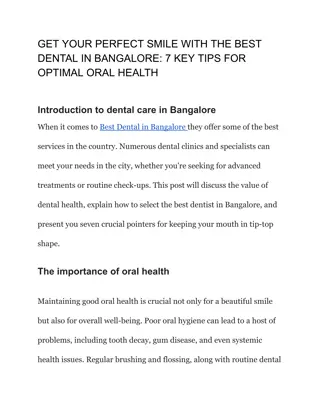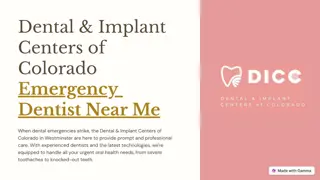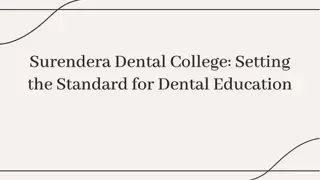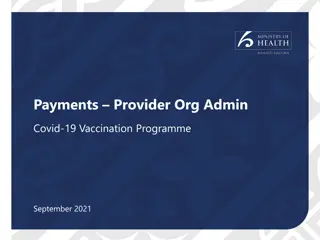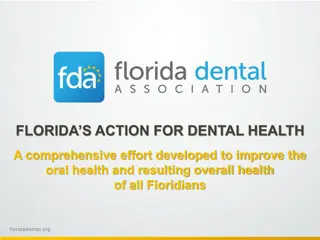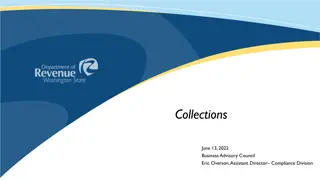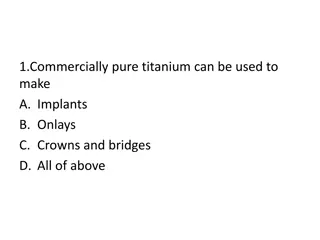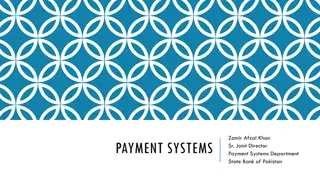Overview of Dental Payment Plans: Private vs. Public Financing
Explore the world of dental payment plans, from traditional fee-for-service models to post-payment plans. Learn about private third-party payment plans and public financing options like Medicare and Medicaid. Discover the advantages and disadvantages of each method, and delve into the evolution of dental payment systems.
Download Presentation

Please find below an Image/Link to download the presentation.
The content on the website is provided AS IS for your information and personal use only. It may not be sold, licensed, or shared on other websites without obtaining consent from the author. Download presentation by click this link. If you encounter any issues during the download, it is possible that the publisher has removed the file from their server.
E N D
Presentation Transcript
DENTAL PAYMENTS A. Anitha, 3rd Yr PG 2
Contents Introduction Classification of payment plan 1.Private Fee for service 2.Post payment plan 3
3.Private third party payment plans For-Profit health service corporation Insurance companies Non-profit health service corporation Delta dental plans Blue cross and blue shields plans Prepaid group practice Managed care HMOs PPOs Direct reimbursement Discount dental plans 4
4.Public financing of health care programmes Medicare Medicaid SCHIP National health insurance Other programmes Health insurance in Indian scenario Conclusion References 5
Introduction Fee-for-service 6
CLASSIFICATION OF PAYMENT PLANS: PRIVATE FEE - FOR - SERVICE Two-party arrangement Traditional form of reimbursement for dental services. Fee-for-service care is an integral part of private practice as a delivery method. Advantages: It is culturally acceptable. Flexible Disadvantages: 7
POST PAYMENT PLANS (budget payment plans): 1 930's by local dental societies in Pennsylvania and Michigan. the patient borrows money from a bank or finance company to pay the dentist's fee. After the application is approved by the lending institution, the dentist is paid the entire fee. The patient then repays the loan to the bank in budgeted amounts. Patient Dentist Bank 8
The problems were associated with defaulted loans and low income patients would also have more difficulty being accepted as credit worthy by lending institutions. 9
PRIVATE THIRD PARTY PREPAYMENT PLANS "payment for services by some agency rather than directly by the beneficiary of those services". carrier, insurer, underwriter or administrative agent. Usually the term "third party" refers to a private carrier such as an insurance company. Brain A.Burt and Stephen A. Eklund, Financing of dental care, Text book of Dentistry, 10 dental practice and the community, 5th edition, 81-107.
Health insurance: an individual or group purchasing health care coverage in advance by paying a fee called premiums. It would be any arrangement that helps to defer, delay, reduce or altogether avoid payment for health care incurred by individuals. Premiums can be collected based on assumption of the risk. 11
Insurance principles and dental care To be insurable, a risk must. Be precisely definable Be of sufficient magnitude that if it occurs, it constitutes a major loss Be infrequent Be of an unwanted nature Be beyond the control of the individual 12
Insurance companies have found that dental insurance can be made more feasible by: 1. Have patient share the cost 2. Limit the range of services available 3. Offering services only to groups 4. Include "waiting period" after enrollment before benefits become payable 5. Use preauthorization and annual expenditure limits 13
Different types of payments offered by the insurer are, 1. Deductible (front-end-payment) 2. Co insurance 3. Group insurance 14
Deductible: It is a stipulated flat sum that the patient must pay toward the cost of treatment before the benefits of the program go into effect. It is sometime called "front-end-payment". 15
Co Insurance: It is also called as "co-payment". Co-insurance is defined as "an arrangement under which a carrier and the beneficiary are each liable for a share of the cost of the dental services provided" It means that the patient pays a percentage of the total cost of treatment. Co- insurance helps to keep premiums down. E.g.: A patient has to pay 20% of the cost of hospital care, the remaining 80% will be paid by the insurance company. Soben peter, Dental payments, Essential of preventive and community dentistry,4th edition, 225-229. 16
Group Insurance: This is health insurance offered only to groups. This is because illness experience is reasonably predictable in a group. The probability of adverse selection is also reduced by the use of waiting periods after enrollment before any benefits become available. The waiting period ensures persons with existing disease are not simply going to use the plan to have that disease treated and then drop out. 17
Reimbursement of dentists in prepayment plans UCR fee A table of allowances Fee schedule Discounted fee Capitation Brain A.Burt and Stephen A. Eklund, Financing of dental care, Text book of Dentistry, dental practice and the community, 5th edition, 81-107. 18
Reimbursement of dentists in prepayment plans.. UCR fee:(usual, customary and reasonable fee) Usual fee: The fee usually charged for a given service by an individual dentist to private patients i.e., his or her usual fee. Customary fee: A fee is customary when it is in the range of the usual fee charged by dentists of similar training and experience for the same service within the specific and limited geographic area. Reasonable fee: The fee charged by a dentist for a specific dental procedure that has been modified by the nature and severity of the condition being treated and by any medical or dental complications or unusual circumstances and that therefore may differ from the usual and customary fee. 19
Reimbursement of dentists in prepayment plans.. A table of allowances: It is a list of covered services that assigns to each service a sum that represents the total obligation of the plan with respect to payment for such service but that does not necessarily represent a dentist's full fee for that service. If the dentist's fee becomes more than that assigned to that service by the carrier, the remainder will be collected by the dentist from the patient. This method of reimbursement is not entirely satisfactory because the patients are often unaware that the plan may not cover them in full for dental care. 20
Reimbursement of dentists in prepayment plans.. Fee schedule It is a list of the charges established or agreed by a dentist for specific dental services. A fee schedule is usually taken to represent payment in full. With a fee schedule, the dentist must accept the listed amount as payment in full and not charge the patient at all. Brain A.Burt and Stephen A. Eklund, Financing of dental care, Text book of Dentistry, dental practice and the community, 5th edition, 81-107. 21
Reimbursement of dentists in prepayment plans.. Discounted fee: Participating dentists have agreed to provide care for fees that are usually lower than the those charged by many dentists in their area. The patient is responsible for all of the difference between the dentist s fee and the amount paid by the plan. 22
Reimbursement of dentists in prepayment plans.. Capitation: It became more common during 1980 and 1990s but plays a much smaller role in dentistry than in medicine. ADA- a dental benefit programme in which a dentist contract with the carrier to provide all or most of the dental services covered under the programme to subscribers for a payment on per capita basis. The dentist receives a fixed sum of money per enrolled person per month regardless of whether the patients utilize care or not during that particular month. 23
Non-profit health service corporation Making profit is not the purpose of these plans, but rather improving access to services. 1. Delta dental plans 2. Blue cross and blue shield 24
Delta dental plans: (Dental Service Corporation) The National Association of Dental Service Plans (NADSP) was formed in June 1 966 with the help from ADA. Delta Dental Plans Association (DDPA) was created in 1966 to bring together these local state service organizations and coordinate dental benefit programs for customers with employees in multiple states. The NADSP changed its name to Delta Dental Plans Association in April 1 969. Brain A.Burt and Stephen A. Eklund, Financing of dental care, Text book of Dentistry, dental practice and the community, 5th edition, 81-107. 25
Delta dental plans It is legally constituted non-profit organization incorporated on a state-by-state basis and sponsored by a constituent dental society to negotiate and administer contracts for dental care. They are usually subject to the insurance laws of the state in which they are constituted. 26
Delta dental plans Reimbursement of dentists in Delta plans: Delta dental plans almost exclusively use the UCR concept. The way in which a dentist is reimbursed depends on whether the dentist is participating or non-participating in the plan. A participating dentist is defined as any duly licensed dentist with whom a Delta plan has a contractual agreement to render care to covered subscribers. 27
Delta dental plans Dentists participating in the plan have to agree to the following conditions, 1. Pre-filing of their usual and customary fees. 2. 90th percentile of fees as payment in full. 3. Fee audits by auditors from Delta plan. 4. Post-treatment inspection of randomly chosen patients to monitor the quality of care. 5. The withholding of a small amount of each fee to go into the Delta capital reserve fund. 28
Delta dental plans Non-participating dentists can also treat patients covered under Delta dental plan. They are paid at a considerably lower percentile than the 90th, often at the median or 50th percentile. They however do not need to prefile their fees and are not subject to fee audits. Brain A.Burt and Stephen A. Eklund, Financing of dental care, Text book of Dentistry, 29 dental practice and the community, 5th edition, 81-107.
90th percentile Range of fees ($) < 10 < 20 < 30 < 40 < 50 < 60 < 70 < 80 frequency(in %) 1 2 5 28 80 95 99 100 30
Blue cross / Blue shield: These non profit health service corporations have for years offered limited dental coverage as a part of medical policies. Dental coverage was usually limited to services provided in a hospital. 31
Health service corporations showed no enthusiasm for going any further into dental prepayment on the grounds that it was a poor insurance risk, but their attitude changed once dental prepayment was shown to be feasible. Blue Cross / Blue Shield dental plans have adopted many of the cost control features pioneered by Delta plans. 32
Prepaid group practice ADA Group practice is that type of practice in which dentists, sometimes in association with the members of other health professions agree formally between themselves on certain central arrangements designed to provide efficient dental health service. US Public health service A group dental practice is defined as a practice formally organized to provide dental care though the services of 3 or more dentists, using office space, equipment and personnel. Soben peter, Dental payments, Essential of preventive and community dentistry,4th edition, 225-229. 33
Types of group practice: General practice groups Single specialty groups Multi- specialty groups 34
Prepaid group practice. Advantages One can have the better way of organizing the life. Less disruption in the practice due to illness. Quality of care will be improved. Financial benefits will be more. 35
Managed care Managed care is an arrangement through which people receive all or most of their health care from providers who are formally linked to an organization. The key elements of managed care are: 1. A comprehensive set of health care services 2. Selected providers 3. Financial incentives to use the selected providers 36
HMOs HMOs implementation was formally promoted with the passage of the HMO act of 1973. HMO is defined as " a legal entity which provides a prescribed range of health services to each individual who has enrolled in the organization, in return for a prepaid, fixed and uniform payment. 37
The four principles that characterize an HMO are, (1) An organized system of health care that accepts the responsibility to provide or otherwise assure the delivery of (2) an agreed-upon set of comprehensive health maintenance and treatment services for (3) a voluntarily enrolled group of people in a geographical area and (4) is reimbursed through a pre-negotiated and fixed periodic payment made by or on behalf of each person or family enrolled in the plan. 38
HMOs An enrolled group : Members of the HMO are those people who voluntarily join the HMO through a contract arrangement in which the enrolled agrees to pay the fixed monthly or other periodic payment to the HMO. Enrollees agree to use the HMO as their principal source of health care if they become ill or need care. 39
HMOs Dental Personnel in HMO's : The staff model. The group model. The independent practice association (IPA). Capitated network or direct contract model. 40
PPO s: ( preferred provider organizations) PPOs along with HMOs are one of the main managed care arrangements. PPOs typically involve contracts between insurers and a number of practitioners who agree to provide specific services for fees that are lower than the average for the area. The contracting dentists usually agree to participate at the lower than usual fees to attract additional patients to their practices. Competition for patients is the driving force. Fee-for-service plans 41
Direct reimbursement It is a form of payment for dental care that has existed informally for a long time. It is promoted by the ADA as an alternative to more common forms of dental insurance. Direct reimbursement involves an agreement between an employer and its employees for some part their expenses for dental care. The premium payments are usually deducted automatically from the pay itself. Brain A.Burt and Stephen A. Eklund, Financing of dental care, Text book of Dentistry, 42 dental practice and the community, 5th edition, 81-107.
Direct reimbursement All treatment decisions are made by the patient and the dentist in a traditional two party manner. Reimbursement is usually on a percentage basis and on annual limits Direct reimbursement also minimizes the administrative costs. Patients also face fewer out of pocket expenses. 43
Discount dental plans These discount plans arise when carriers develop panels of dentists who agree to lower than average or discount fees, similar to PPOs. The difference from other forms of coverage is that the patient is responsible for 100% of the discounted fee. 44
Public financing of health care programmes Medicare In the USA, title XVIII of the Social Security Amendments of 1 965 is the program known as "Medicare". This program removed all financial barriers for hospital and physician services for all persons aged 65 and over, regardless of their financial means. By the mid-1970's, Medicare had two parts, Part A: Hospital Insurance. Part B: Supplemental Medical Insurance. 45
Medicare Both parts contain a highly complex series of service benefits available and both parts also require some payment by the patient. Medicare was brought into being because the voluntary health insurance system was unable to provide adequately for persons over age 65. 46
Medicare The health insurance industry primarily operates for profit and those over 65 are a high-risk group in terms of general health care needs. Because the income of persons aged 65 and older is considerably less, they have limited funds to spend on health care. The dental segment of Medicare is limited to those services requiring hospitalization for treatment, usually surgical treatment for fractures and cancer and hence constitutes a negligible proportion of the program. 47
Medicaid It is the name given to title XIX of the United States Social Security Amendments of 1965. The original intent of the program was to provide funds to meet the health care needs of all indigent and medically indigent persons. 48
Medicaid Medicaid is covering the basic services, Inpatient hospital care Outpatient hospital care Laboratory and X-ray services Skilled nursing facility services Home health services for individuals aged 21 years and older Early and periodic screening, diagnosis and treatment (EPSDT) program for individuals under21 years Family planning services Physician services 49
Medicaid The ADA supported the EPSDT program, enacted into law in 1968, because for the first time a federal program mandated dental care for indigent children. EPSDT therefore had the potential for bringing into the dental care system, millions of indigent children and youth. Medicaid is an extremely complex program. 50






